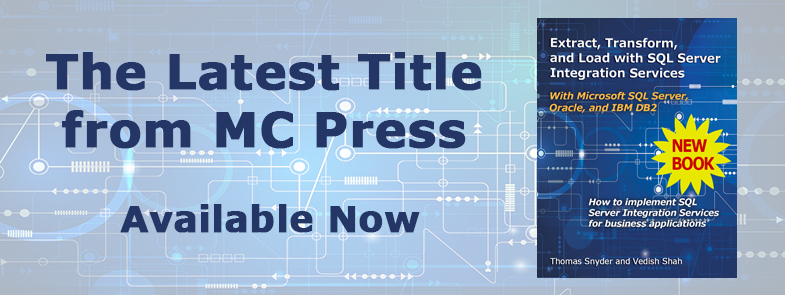Do your business apps access different data sources? This book shows you how to make that task easier
As a developer, I have often worked with business applications that pull in data from various sources, such as files or databases, and send that data to multiple destinations. This sounds simple enough, but clients and/or applications typically do not send or receive data the same way. So, what happens when you must update that data for the destination to take it in? There are multiple tools you can use to modify (transform) this data—essentially, the extract, transform, and load (ETL) concept. Wouldn’t it be great to have one tool to handle multiple ETL scenarios? That’s where Extract, Transform, and Load with SQL Server Integration Services: With Microsoft SQL Server, Oracle, and DB2 comes into play. This book is exactly what the title states. In it, authors Thomas Snyder and Vedish Shah dive into how to use Microsoft’s SQL Server Integration Services (SSIS) to accomplish these tasks.
I really enjoyed how this book was written, starting with the introduction, which grabbed my attention right away and made me excited to dive in to the rest of the book. The book starts off by explaining the environment and giving an overview of how the authors will demonstrate how to SSIS to build practical business solutions.
Clear and Logical, Right from the Start
One major problem I have with many technical books is that they don’t explain how to set up the full environment for the reader to use. Such books assume that you will figure out how to do the setup by finding the instructions and required downloads on the appropriate forums and websites. I was excited to see that in Extract, Transform, and Load with SQL Server Integration Services the authors include instructions for setting up the environments necessary to use the Microsoft and Oracle tools their SSIS solution requires. The book also provides the code (downloadable) that you will need to set up the tables and data used for the projects described in the book.
The authors delve into SSIS development concepts and techniques in a clean, logical sequence, at a pace that is easy to follow. The order of the chapters follows the SSIS system development life cycle: the authors spend the first half of the book discussing how to develop solutions for the various ETL scenarios, and then move on to discussing the later-stage topics of deployment and execution. Each chapter provides a foundation for topics that are discussed in later chapters, so that you grasp and assimilate the concepts and techniques by learning the fundamentals and building upon that knowledge.
Experienced Guidance in SSIS ETL
For example, the book starts by taking you step by step through creation of a base project that is used in subsequent chapters, which saves you time when creating other projects. Chapter 7 explains how to pull data from the database to create files, and then Chapter 8 uses those files to load to the database. The book also discusses multiple input and output formats, such as XML, CSV, fixed-width, and Excel, covering the file types most commonly used for business data operations.
I like when a book has a personalized feel, as if the author is guiding you as an experienced mentor. You can immediately tell that Thomas Snyder and Vedish Shah are writing from personal experience. They discuss common errors they have faced, the reason the errors occurred, and how to resolve them. The authors also provide various tips and notes throughout the chapters that will make it easier for the reader to navigate the SSIS ETL process.
Extract, Transform, and Load with SQL Server Integration Services is well written and easy to follow. It is an excellent guide that truly touches on all the important aspects of using SSIS in a variety of ETL scenarios. This book could easily be used as a teaching tool for students, interns, or even as a reliable resource for experienced SSIS developers to consult when they need an ETL refresher.













 Business users want new applications now. Market and regulatory pressures require faster application updates and delivery into production. Your IBM i developers may be approaching retirement, and you see no sure way to fill their positions with experienced developers. In addition, you may be caught between maintaining your existing applications and the uncertainty of moving to something new.
Business users want new applications now. Market and regulatory pressures require faster application updates and delivery into production. Your IBM i developers may be approaching retirement, and you see no sure way to fill their positions with experienced developers. In addition, you may be caught between maintaining your existing applications and the uncertainty of moving to something new. IT managers hoping to find new IBM i talent are discovering that the pool of experienced RPG programmers and operators or administrators with intimate knowledge of the operating system and the applications that run on it is small. This begs the question: How will you manage the platform that supports such a big part of your business? This guide offers strategies and software suggestions to help you plan IT staffing and resources and smooth the transition after your AS/400 talent retires. Read on to learn:
IT managers hoping to find new IBM i talent are discovering that the pool of experienced RPG programmers and operators or administrators with intimate knowledge of the operating system and the applications that run on it is small. This begs the question: How will you manage the platform that supports such a big part of your business? This guide offers strategies and software suggestions to help you plan IT staffing and resources and smooth the transition after your AS/400 talent retires. Read on to learn:
LATEST COMMENTS
MC Press Online